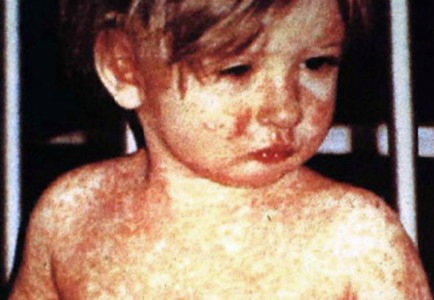A disease that was practically non-existent in the United States took the nation by surprise last year when a reported 644 measles cases popped up. As the medical community tried to pin down the origins of this outbreak, the anti-vaccine camp (including comedian/actress Jenny McCarthy, who publicly speaks out against them, tying vaccines to autism) was identified as a possible connection to sudden surge in measles.
McCarthy, along with many others believe vaccines are dangerous and are a part of a movement that encourages parents to not vaccinate their children, which may be allowing the disease to spread more easily.
Disneyland in Orange County, California was dubbed ground zero for the most recent outbreak.
However, a recent Vox.com article traces the beginning of the recent American measles surge to an Amish missionary worker’s travels in the Philippines.
The unnamed missionary worker, dubbed patient zero, travelled from Ohio, his home state, to the Philippines in a plane.
During that time, the Philippines was having a massive measles outbreak and patient zero contracted the disease and brought it back to the U.S. on his return trip.
The missionary was not vaccinated. As a matter of fact, a large part of the Amish population aren’t vaccinated because many of them also believe vaccinations are dangerous.
That belief is said to stem from an incident in the 1990s. According to Ivan Miller, an Ohio Amish furniture store owner, two children who took the MMR shot, which protects against measles, mumps and rubella, became very ill.
That incident spurred a negative, dangerous viewpoint regarding vaccines and a significant portion of the community decided not to vaccinate their children.
Two decades later, an infected patient zero returned from his missions trip to a community that was mostly unprotected from this condition, and measles spread through the population like wildfire.
When he initially fell sick, his doctor misdiagnosed him with dengue fever, and patient zero continued to interact with his friends and family, spreading the illness.
While the disease is rarely fatal (1 to 2 children out of 1,000 die), it can be very debilitating, causing large, rashes over the body, pneumonia or encephalitis, to name a few.
As the disease continued to spread, a member of the Amish community made a phone call to the Ohio health department using a pay phone to let officials know there was a potential measles outbreak.
This proved to be a challenging issue for the health department to address, considering most of the Amish community didn’t have personal phones, vehicles or many of the modern modes of communication and transportation.
It took months for the health department to try and contain the outbreak, and once they did, 382 outbreak cases were confirmed, with about 8 patients who needed to be hospitalized since they were in severe condition.
After experiencing the severity of an infectious disease like the measles, the Ohioan furniture store said that many members of the Amish community changed their tune, deciding to overlook their adverse feelings toward vaccinations and get the shots.
That’s a step in the right direction, considering vaccinations is what allowed the United States to declare the nation measles free in 2000.
However, the World Health Organization (WHO) claims there are many other pockets of unvaccinated communities that are just a ticking time bomb.
They just mostly go undetected, until a person carrying the illness from overseas excuses unprotected communities. A religious Dutch community in Canada who also refused vaccination experienced a similar fate last year with 400 measles cases.
It’s hard to say whether the spike in measles cases will inspire anti-vaccination groups to protect themselves and their children, but as of January 2015, 14 states in the U.S. have reported new measles cases.
This issue has sparked some interesting discussion as to whether vaccinations should be 100 percent mandatory, regardless of personal philosophies.
What do you think?
For more on the Ohio Amish measles outbreak, visit here: http://www.vox.com/2015/1/29/7929791/measles-outbreak-2014
For more on the national outbreak, visit here: http://www.cnn.com/2015/02/02/health/measles-how-bad-can-it-be/

